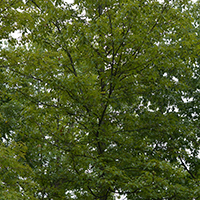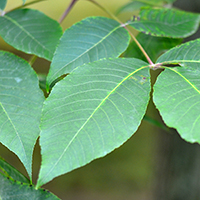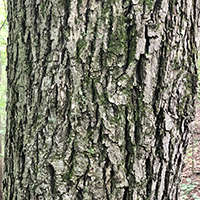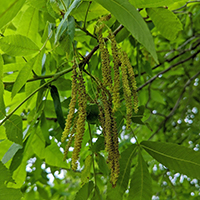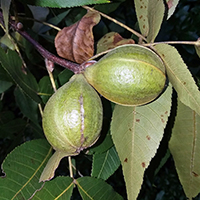What pignut hickory looks like
Size and shape
- Reaches 20 metres tall.
- Trunk up to 50 centimetres in diameter.
Leaves
- Dark yellow-green compound leaves (15 to 25 centimetres).
- Have 5 to 7 leaflets with narrow-pointed tips.
Bark
- Grey, thin and scaly bark with intersecting ridges.
Flowers
- Male flowers grow as hanging catkins with 3 branches.
- Female flowers grow in small spikes.
- Flowers appear in spring.
Fruit
- Green husk is pear-shaped and smooth.
- Contains small, dark brown nuts (20 to 25 millimetres).
- Easily split from top to bottom into 4 sections.
Where pignut hickory is found
Pignut hickory is found scattered in regions of Southern Ontario bordering lakes Erie and Ontario.
What you need to know to grow pignut hickory
- Moisture: grows best in well drained soils.
- Soil: grows best in loamy and silty clay soils but will adapt to a variety of soil types.
- Shade: requires full sunlight.
- Cautions:
- Pignut hickory nuts are not edible and have bitter kernels.
- Pignut hickory has a long taproot, which can make it difficult to transplant.
Benefits and uses of pignut hickory
Wildlife benefits
Pignut hickory provides cover for a variety of birds and small mammals and serves as denning sites for squirrels. They are also hosts to many moth species.
Commercial uses
Pignut hickory has strong, durable wood. It has been used to create:
- tools
- sports equipment
- wagon wheels
- early car parts
- skis
Fun facts about pignut hickory
- Pignut hickory can live up to 200 years.
- Pignut hickory nuts were formerly fed to pigs, which is where the tree got its name.
Updated: November 22, 2023
Published: August 22, 2023
